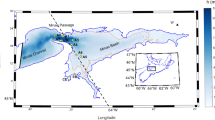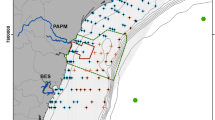Abstract
The paper addresses the individual and collective contribution of different forcing factors (tides, wind waves, and sea-level rise) to the dynamics of sediment in coastal areas. The results are obtained from simulations with the General Estuarine Transport Model coupled with a sediment transport model. The wave-induced bed shear stress is formulated using a simple model based on the concept that the turbulent kinetic energy (TKE) associated with wind waves is a function of orbital velocity, the latter depending on the wave height and water depth. A theory is presented explaining the controls of sediment dynamics by the TKE produced by tides and wind waves. Several scenarios were developed aiming at revealing possible trends resulting from realistic (observed or expected) changes in sea level and wave magnitude. The simulations demonstrate that these changes not only influence the concentration of sediment, which is very sensitive to the magnitude of the external forcing, but also the temporal variability patterns. The joint effect of tides and wave-induced bed shear stress revealed by the comparison between theoretical results and simulations is well pronounced. The intercomparison between different scenarios demonstrates that the spatial patterns of erosion and deposition are very sensitive to the magnitude of wind waves and sea-level rise. Under a changing climate, forcing the horizontal distribution of sediments adjusts mainly through a change in the balance of export and import of sediment from the intertidal basins. The strongest signal associated with this adjustment is simulated North of the barrier islands where the evolution of sedimentation gives an integrated picture of the processes in tidal basins.














Similar content being viewed by others
References
Bruun P (1962) Sea level rise as a cause of shore erosion. J Waterw Harb Div-ASCE 88:117–130
Bruun P (1978) Stability of tidal inlets. Theory and engineering. Developments in geotechnical engineering 23. Elsevier, Amsterdam, p 506
Burchard H, Bolding K (2002) GETM—a general estuarine transport model. Scientific documentation, No EUR 20253 EN, European Commission, Italy, p 157
Burchard H, Bolding K, Villareal MR (1999) GOTM—a general ocean turbulence model. Theory, implementation and test cases scientific documentation, No EUR 18745 EN, European Commission, Italy, p 103
Clarke S, Elliot AJ (1998) Modelling suspended sediment concentrations in the firth of forth. Estuar Coast Shelf Sci 47:235–250
Davies AM, Lawrence J (1994) Examining the influence of wind and wind wave turbulence on tidal currents, using a three-dimensional hydrodynamic model including wave-current interaction. J Phys Oceanogr 24:2441–2460
Dick SK, Eckard K, Müller-Navarra SH, Klein H, Komo H (2001) The operational circulation model of BSH (BSHcmod)—model description and validation. Berichte des Bundesamtes für Seeschifffahrt und Hydrographie 29:49
Dyer KR, Soulsby RL (1988) Sand transport on the continental shelf. Annu Rev Fluid Mech 20:295–324
Einstein HA, Krone RB (1962) Experiments to determine modes of cohesive sediment transport in salt water. J Geophys Res 67:1451–1461
Flemming BW (2002) Effects of climate and human interventions on the evolution of the Wadden Sea depositional system (Southern North Sea). In: Wefer G, Behre K-E, Jansen E (eds) Climate development and history of the North Atlantic realm. Springer, Berlin Heidelberg New York, pp 399–413
Flemming BW, Davis RA (1994) Holocene evolution, morphodynamics and sedimentology of the Spiekeroog barrier island system (southern North Sea). Senckenb Marit 24:117–155
Forbes DL, Orford JD, Taylor RB, Shaw J (1997) Interdecadal variation in shoreline recession on the Atlantic coast of Nova Scotia. In: Proceedings of the Canadian coastal conference ‘97, Guelph, Ontario. Canadian Coastal Science and Engineering Association, Ottawa, ON, Canada, pp 360–374
Friedrichs CT, Aubrey DG, Speer PE (1990) Impact of relative sea-level rise on evolution of shallow estuaries. In: Cheng RT (ed) Residual currents and long-term transport. Springer, Berlin Heidelberg New York, pp 105–122
Grant WD, Madsen OS (1979) Combined wave and current interaction with a rough bottom. J Geophys Res 84:1797–1808
Jonsson IG (1966) Wave boundary layers and friction factors. In: Proceedings of the 10th international conference on coastal engineering, Tokyo, Japan, ASCE, pp 127–148
Kaplin PA, Selivanov AO (1995) Recent coastal evolution of the Caspian Sea as a natural model for coastal responses to the possible acceleration of global sea-level rise. Mar Geol 124:161–175
Komar PD, Enfield DB (1987) Short-term sea-level changes and coastal erosion. In: Nummedal D, Pilkey OH, Howard JD (eds) Sea-level fluctuation and coastal evolution. Society of Economic Paleontologists and Mineralogists, Tulsa OK, special publication no. 41, pp 17–27
Krögel F, Flemming BW (1998) Evidence for temperature adjusted sediment distribution in the backbarrier tidal flats of the East Frisian Wadden Sea (southern North Sea). In: Alexander CR, Davis RA, Henry VJ (eds) Tidalites: processes and products, vol 61. SEPM Spec, pp 31–41
Le Hir P, Roberts W, Cacaille O, Christie M, Bassoulet P, Bacher C (2000) Characterization of intertidal flat hydrodynamics. Cont Shelf Res 20:1433–1459
Mehta AJ (1988) Laboratory studies on cohesive sediment deposition and erosion. In: Dronkers J, van Leussen W (eds) Physical processes in estuaries. Springer, Berlin Heidelberg New York, pp 327–345
Nicholls RJ (1998) Assessing erosion of sandy beaches due to sea-level rise. In: Maund JG, Eddleston M (eds) Geohazard in engineering geology, vol 15. Engineering Geology Special Publications, Geological Society, London, United Kingdom, pp 71–76
Partheniades E (1965) Erosion and deposition of cohesive soils. Proc ASCE, J Hydraulics Div 91:105–139
Puls W, Sündermann J (1990) Simulation of suspended sediment dispersion in the North Sea. In: Cheng RT (ed) Coastal and estuarine studies, 38, Residual currents and long-term transport. Springer, Berlin Heidelberg New York
Roberts WR, Le Hir P, Whitehouse RJS (2000) Investigation using simple mathematical models of the effect of tidal currents and waves on the profile shape of intertidal mudflats. Cont Shelf Res 20:1079–1097
Rodi W (1980) Turbulence models and their application in hydraulics. Report Int Assoc Hydraul Res, Delft, Netherlands, p 104
Santamarina Cuneo P, Flemming B (2000) Quantifying the concentration and flux of suspended particulate matter through a tidal inlet of the East Frisian Wadden Sea by acoustic Doppler current profiling. In: Flemming BW, Delafontaine MT, Liebezeit G (eds) Muddy coast dynamics and resource management. Elsevier Science, Amsterdam, The Netherlands, pp 39–52
Schubert M, Blender R, Fraedrich K, Lunkeit F, Pertwitz J (1998) North Atlantic cyclones in CO2-induced warm climate simulations: frequency, intensity and tracks. Clim Dyn 14:827–837
Signell RP, Beardsley RC, Graber HC, Capotondi A (1990) Effect of wave-current interaction on wind-driven circulation in narrow, shallow embayments. J Geophys Res 95:9671–9678
Souza AJ, Simpson JH (1997) Controls on stratification in the Rhine ROFI system. J Mar Syst 12:311–323
Stanev EV, Flöser G, Wolff J-O (2003a) Dynamical control on water exchanges between tidal basins and the open ocean. A Case Study for the East Frisian Wadden Sea. Ocean Dynamics 53:146–165
Stanev EV, Wolff J-O, Burchard H, Bolding K, Flöser G (2003b) On the circulation in the East Frisian Wadden Sea: numerical modeling and data analysis. Ocean Dynamics 53:27–51
The WASA Group (1998) Changing waves and storms in the Northeast Atlantic? Bull Am Meteorol Soc 79(5):741–760 (May 1998)
van der Molen J, de Swart HE (2001) Holocene wave conditions and wave-induced sand transport in the Southern North Sea. Cont Shelf Res 21:1723–1749
van Leussen W (1988) Aggregation of particles, settling velocity of mud flocks. In: Dronkers J, van Leussen W (eds) Physical processes in estuaries. Springer, Berlin Heidelberg New York, pp 347–404
Author information
Authors and Affiliations
Corresponding author
Additional information
Responsible editor: Alejandro J. Souza
Appendix 1
Appendix 1
Here, we will use for the bed shear stress Eq. 10 and, as done in many theoretical studies of the bottom layer, we parameterize \(\tau_b^t\) as
where \(u\) is the mean velocity.
We will apply the above equations to an idealized topography with a constant slope \(a=\frac{dh}{dx}\) (Fig. 15). For simplicity, we will assume that \(\zeta=\frac{r}{2}cos\omega t\) where \(r\) is the tidal range (Fig. 16a), that is we neglect the spatial dependence. As demonstrated by SFW, this assumption is approximately valid over the tidal flats. The volume of water between the location where the depth is \(H_{lw}\) (see Fig. 15) and the movable boundary is
where \(y_0\) is the extension along the coast of the area, \(x_{lw}=\frac{H_{lw}}{a}\) is the distance between location where the depth is \(H_{lw}\) and the coast, \(\Delta x=\frac{\zeta}{a}\) The total transport is \(Tr=\frac{dV}{dt}=x\frac{d\zeta}{dt}y_0\) where \(x=\frac{(H_{lw}+\zeta)}{a}\) is the extension of the flooded area. Velocity is computed as \(v=\frac{1}{y_0(H_{lw}+\zeta)}\frac{dV}{dt}\) and for the given \(\zeta\) is \(v=-\frac{r\omega}{2a}sin\omega t\) The corresponding bed shear stress computed from Eq. 22
is shown in Fig. 16b. This is a bimodal oscillation shaped by the maxima of current speed.
The importance of the limiting factor \((H/h)_{lim}\) in Eq. 12 is revealed below from the comparison between Figs. 16, 17, and 18 in which \((H/h)_{lim}\) is 0.15, 0.5, and 0.8, correspondingly. The friction factor in the first and third case is changed compared to the basic case (Fig. 17) in a way to ensure comparable magnitudes of bed shear stress. Obviously, beyond some values of \((H/h)_{lim}\) the temporal variability follows a similar pattern (compare Figs. 17 and 18), however, for small limiting factors such as those reported by Le Hir et al. (2000), the course of curves change substantially (some maxima disappear).
Following the simple model of Eq. 12 with \((H/h)_{lim}=0.5\) and \(f_w=0.005\) the bed shear stress at \(x=0\) (local depth \(H_{LW}\)) due to wind waves follows different patterns depending on the wave height (Fig. 17a,b). For small waves (Fig. 17a), the minimum stress occurs during low and high water. Both minima are lower than the critical value of 0.2N\(\rm {m^{-2}}\) thus enabling a deposition during these times. The temporal variability of bed shear stress due to high waves (Fig. 17b) reveals that only during low water are the values lower than the critical ones. Although there is a secondary minimum during high water, the corresponding values are too high to allow sedimentation. Thus, the total shear stress (Fig. 19b) demonstrates that depending on the wave height, favorable conditions for deposition (blue color) could occur two times per tidal period (for small waves) and one time for high waves. As seen in Fig. 19a, for waves with a constant height, the dependence of bed shear stress on the bottom slope is also very pronounced. For small slopes velocity is large and the bimodal oscillations are better pronounced. For relatively steeper bottom, the control of wind waves becomes dominant (the time of erosion decreases and that of deposition increases).
The above behavior of the bed shear stress due to breaking wind waves becomes clear if we express Eq. 11 as:
for small depths and
for large depths where \(h_0\) is the mean depth. Thus, depending on the ratio between wind-wave magnitude and local depth, the control on bed shear stress is taken either by Eq. 25 or 26. The first case is clearly represented in Fig. 16d.
Because in the near-coastal zone \(\zeta\) reaches values that are comparable with the mean depth, the bed shear stress is expected to show a strong sensitivity to oscillations in sea level. Critical conditions (maximum in Fig. 3) are reached two times per tidal period. This is the reason for the bimodal oscillations of bed shear stress (Fig. 17). It is noteworthy that depending on the wave height, the “spikes” in the bed shear occur earlier for high waves and with some delay for the low wave heights. Therefore, there is an asymmetry of the response of bed shear stress to tidal forcing characterized with a pronounced spatial pattern.
Rights and permissions
About this article
Cite this article
Stanev, E.V., Wolff, JO. & Brink-Spalink, G. On the sensitivity of the sedimentary system in the East Frisian Wadden Sea to sea-level rise and wave-induced bed shear stress. Ocean Dynamics 56, 266–283 (2006). https://doi.org/10.1007/s10236-006-0061-6
Received:
Accepted:
Published:
Issue Date:
DOI: https://doi.org/10.1007/s10236-006-0061-6









